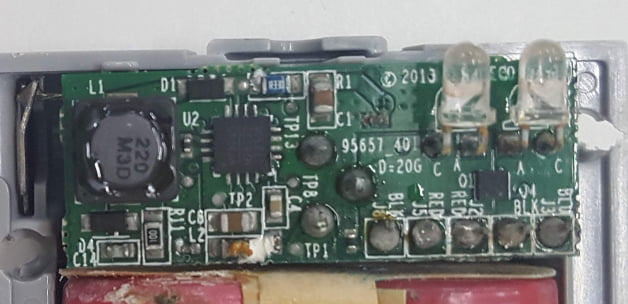Ever wondered what the inside of an EV3 battery looks like? No? Well we’re gonna show you anyway!
As it happens, I got my hands on a defective EV3 battery. Zero voltage and won’t charge. Rather than just chucking it into the trash, I figured that I’ll break it open and take a look inside.
WARNING! Dismantling an EV3 battery can be dangerous. Any damage to the lithium ion battery within may result in a fire.
Breaking it open
The EV3 battery is sealed using 5 metal pegs. These are not screws, and appears to be molded into the plastic. Far as I can tell, there’s no way of removing these pegs without damaging the plastic case.
My approach was to drill away the plastic surrounding the metal pegs. With enough of the plastic drilled away, I was able to pry the metal pegs out and open the case.
Internal Components
Inside the plastic case, you will find…
- 2 x 18650 Lithium Ion batteries marked “16Wh”.
- 1 charging circuit. This is where the barrel socket and the LEDs are mounted.
- 1 protection circuit(?). This is mounted on the 18650 batteries. Not entirely sure what it is for, but it’s likely to be a protection circuit for the batteries.

Charging Circuit
The charging circuit is equipped with a Monolithic Power MP26123 battery charging IC. It’s rated for 9 to 24V, so the official Lego charger (10V) is on the lower end of this range. For those thinking of switching to a higher voltage charger; it’s not gonna charge your batteries any faster. The charging IC regulates the voltage and current, so it’ll be around the same regardless of your supply voltage. But it does mean that it’s probably safe to use the much more common 12V power supply to charge the battery.
Besides the charging IC, there is also a International Rectifier HS8242 power MOSFET. This is probably a replacement for a diode, to prevent the battery voltage from back-flowing to the charger. Nothing else really stands-out.

Protection Circuit(?)
I’m guessing this is the battery protection circuit, but didn’t examine it much. It is equipped with two Alpha and Omega Semiconductor 7426 N-Channel MOSFET.


